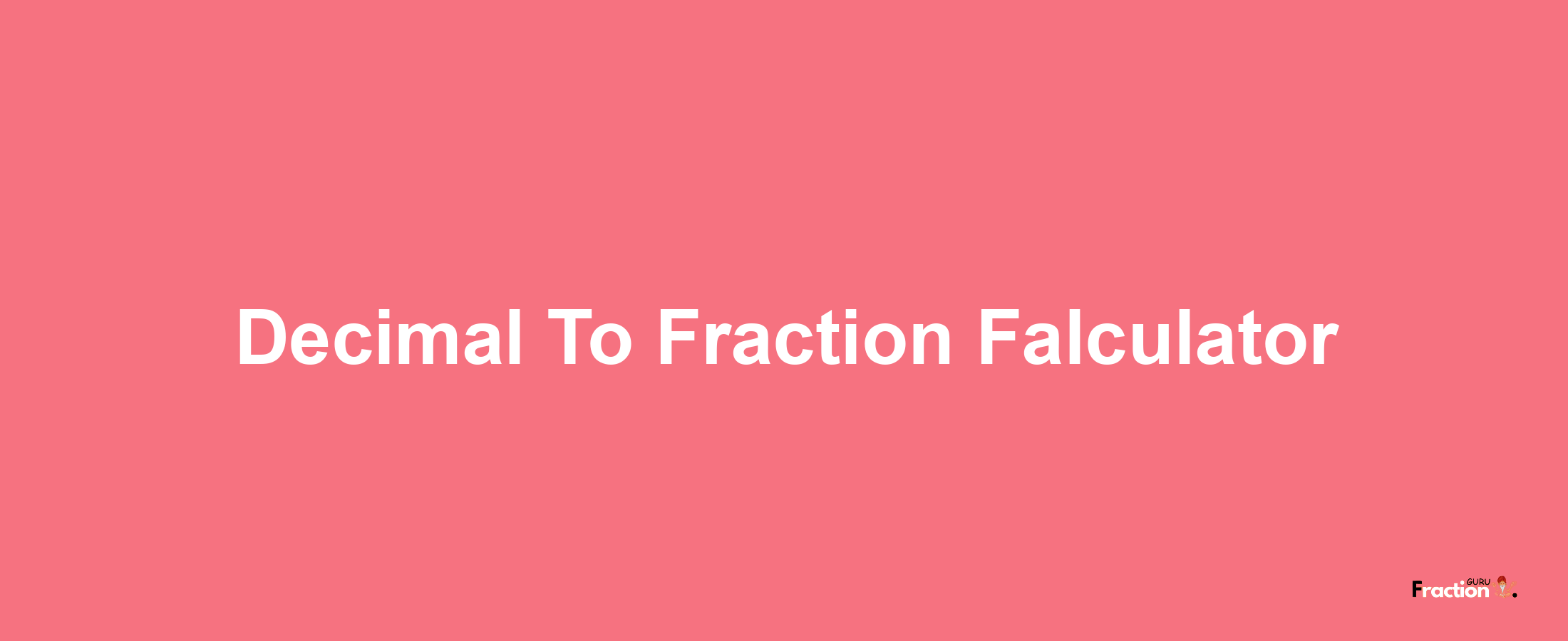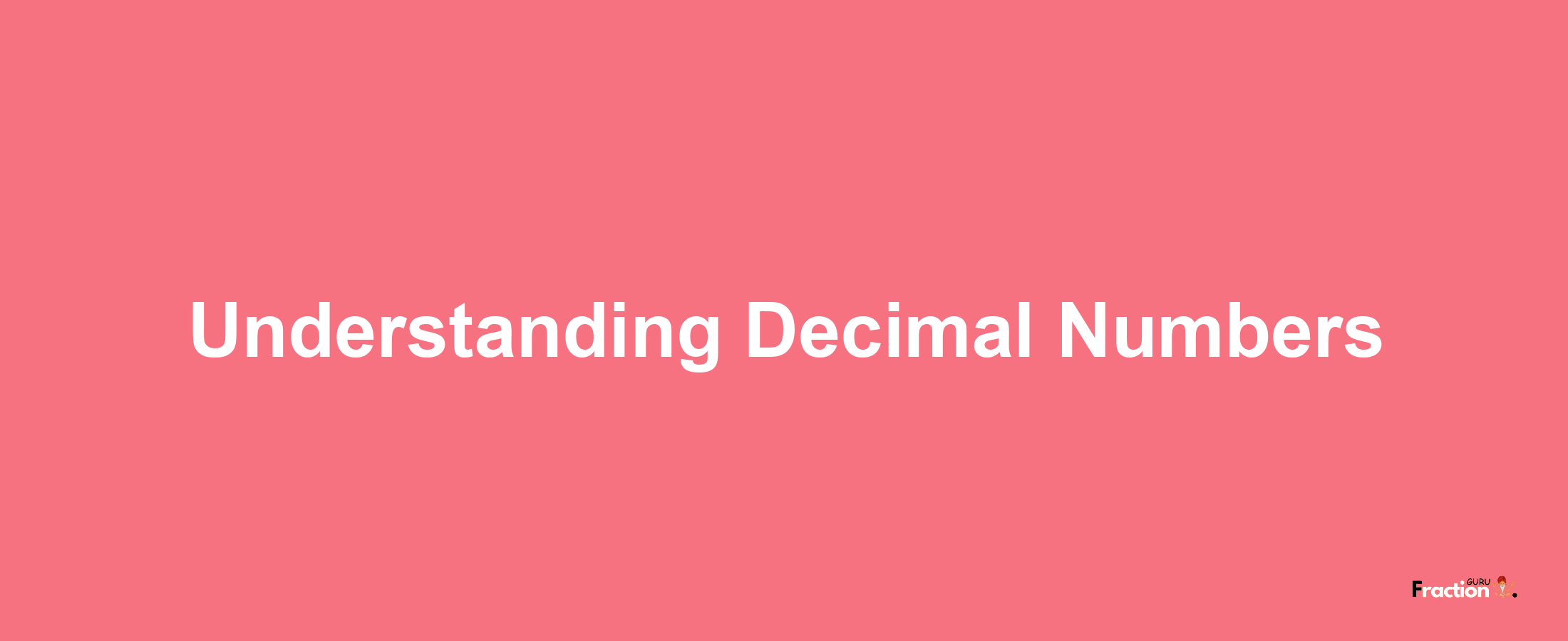
Share This Page:
Decimal to fraction calculator

Welcome to Fraction Guru's Decimal to Fraction Converter! This powerful Decimal as a fraction tool allows you to quickly and accurately convert decimal numbers into fractions. Whether you're a student studying fractions or professional needing precise fraction values, our converter is here to assist you.
Using our user-friendly interface, you can effortlessly convert any decimal number to its equivalent fraction representation. Simply enter the decimal value you wish to convert in the designated box, and our calculator will instantly display the corresponding fraction.
Decimal to Fraction

Have you ever wondered how to convert a decimal to a fraction? Converting decimals to fractions is a fundamental skill that can come in handy in various fields such as mathematics, engineering, and everyday life situations. Whether you're working on math problems or need to represent a decimal value in fraction form, this article will guide you through the process. In this article, we will explore different methods to convert decimals to fractions and provide step-by-step examples to help you grasp the concept.
Understanding Decimal Numbers

Before we delve into converting decimals to fractions, let's first ensure we have a clear understanding of decimal numbers. Decimals are a way to express parts of a whole number. They are based on powers of 10, with each digit to the right of the decimal point representing a fraction of a power of 10. For example, in the decimal number 3.25, the digit 3 represents 3 units, the digit 2 represents 2 tenths, and the digit 5 represents 5 hundredths.
The Basics of Fractions

Fractions, on the other hand, are a way of representing numbers that express a part of a whole. They consist of a numerator (the top number) and a denominator (the bottom number). The numerator represents the number of parts we have, while the denominator represents the total number of equal parts in a whole. For instance, in the fraction 1/4, the numerator is 1, indicating that we have one part, and the denominator is 4, signifying that there are four equal parts in the whole.
Converting Decimals to Fractions: Method 1 - Using Place Value

One method to convert a decimal to a fraction involves utilizing the place value of each digit. Follow these steps:
- Identify the place value of the rightmost digit after the decimal point.
- Write the digit as the numerator.
- Determine the denominator based on the place value:
- If the digit is in the tenth place, the denominator is 10.
- If the digit is in the hundredth place, the denominator is 100.
- If the digit is in the thousandth place, the denominator is 1000.
- Continue this pattern for additional decimal places.
Converting Decimals to Fractions: Method 2 - Using Division

Another approach to converting decimals to fractions involves division. Here's how you can do it:
- Write down the decimal number as the numerator.
- Determine the denominator by using the appropriate power of 10 based on the number of decimal places.
- Simplify the fraction, if possible, by dividing both the numerator and denominator by their greatest common divisor (GCD).
Converting Terminating Decimals to Fractions

Terminating decimals are decimals that have a finite number of digits after the decimal point. Converting them to fractions is relatively straightforward. Here's the general procedure:
- Identify the number of decimal places in the terminating decimal.
- Write the decimal number as the numerator.
- Determine the denominator by using the appropriate power of 10 based on the number of decimal places.
- Simplify the fraction, if necessary, by dividing the numerator and denominator by their GCD.
Converting Repeating Decimals to Fractions

Repeating decimals, also known as recurring decimals, are decimal numbers that have a repeating pattern of digits after the decimal point. Converting repeating decimals to fractions requires a slightly different approach. Follow these steps:
- Assign a variable to the repeating digit(s).
- Subtract the variable from the original number, aligning the decimal places.
- Determine the numerator by subtracting the non-repeating part from the repeating part.
- Determine the denominator by subtracting the repeating part from the original number, and aligning the decimal places.
- Simplify the fraction, if possible, by dividing both the numerator and denominator by their GCD.
Simplifying Fraction Results

After converting a decimal to a fraction, it's often beneficial to simplify the fraction to its simplest form. To simplify a fraction, divide both the numerator and denominator by their GCD. This ensures that the fraction is expressed in its most reduced form.
Examples and Step-by-Step Conversions

Let's walk through a few examples to illustrate the conversion process. We will cover both terminating and repeating decimals, providing clear step-by-step instructions to help you understand the concepts better.
Common Mistakes to Avoid

Converting decimals to fractions can be a bit tricky, especially when dealing with repeating decimals or unfamiliar numbers. Here are some common mistakes to watch out for and avoid:
- Forgetting to align decimal places when subtracting or performing calculations.
- Failing to simplify the resulting fraction.
- Using the wrong power of 10 when determining the denominator.
- Misinterpreting the repeating pattern in repeating decimals.
Practical Applications of Decimal to Fraction Conversion

Understanding how to convert decimals to fractions has practical implications in various fields. Some real-life applications include:
- Converting measurements expressed in decimal form to fractions for ease of understanding.
- Working with financial calculations that involve fractional values.
- Expressing probabilities or ratios in fraction form.
- Solving mathematical problems that require fractions as solutions.
How to Use the Decimal to Fraction Converter Online

Now, let's get to the main event - how to use our decimal to fraction calculator. It's actually quite simple!
First, enter the decimal you want to convert into the calculator. Then, click the "Calculate" button. Voila! The calculator will give you the corresponding fraction.
For example, let's say you want to convert 0.75 to a fraction. Enter 0.75 into the calculator and click "Calculate." The result will be 3/4.
It's important to note that the calculator will only give you a simplified fraction. So if the decimal you entered can be simplified further, the calculator will do so.
Why Use Fraction Guru's Decimal to Fraction Converter?

-
Accuracy: Our converter employs advanced algorithms to ensure precise and reliable decimal to fraction conversions. You can trust our tool to provide accurate results for any decimal number you input.
-
Efficiency: With our user-friendly interface, you can quickly convert decimals to fractions without any hassle. Save time and effort by using our efficient conversion tool.
-
Versatility: Fraction Guru's Decimal to Fraction Converter is suitable for a wide range of applications, including mathematics, engineering, cooking, and more. It is an essential tool for anyone working with fractions.
-
Educational Resource: Students and educators can use our converter as a valuable learning aid. It helps reinforce the understanding of fractions by visualizing decimal-fraction relationships.
Interesting Facts About Fractions

Now that you know how to convert decimals to fractions, let's dive into some interesting facts about fractions.
- The ancient Egyptians were the first to use fractions.
- The word "fraction" comes from the Latin word "fractus," which means "broken."
- The fraction 1/81 is interesting because its decimal equivalent is 0.012345679012345679... - notice how the numbers repeat in the same order!
- The fraction 0/0 is undefined - it cannot be simplified to a whole number.
Conclusion
In conclusion, our decimal to fraction calculator is a useful tool to have in your arsenal. Knowing how to convert decimals to fractions is important in many areas of life, and can even come in handy in math classes. Plus, learning some fun facts about fractions never hurts!
FAQs
Q1. Can all decimal numbers be converted to fractions? Yes, all decimal numbers can be converted to fractions, but the resulting fractions may be terminating or repeating, depending on the decimal.
Q2. Are there any shortcuts or tricks to convert decimals to fractions? While there aren't specific shortcuts, becoming familiar with the methods outlined in this article and practicing regularly can help you become faster and more efficient in converting decimals to fractions.
Q3. Can fractions be converted back to decimals? Yes, fractions can be converted back to decimals using division. Divide the numerator by the denominator to obtain the decimal equivalent.
Q4. Are there any online tools available for decimal to fraction conversion? Yes, there are several online decimal to fraction converters that can provide instant conversions. However, it's essential to understand the underlying concepts and methods manually.
Q5. Why is it important to simplify fractions after conversion? Simplifying fractions ensures that they are expressed in their simplest form. It makes them easier to work with and understand, especially in mathematical calculations.
Start using our Decimal to Fraction Converter now and experience the convenience and accuracy it provides. Simplify your decimal-to-fraction conversions with Fraction Guru!

